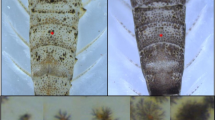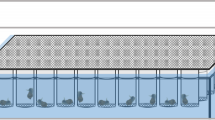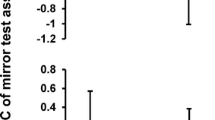Abstract
Endogenous estrogens are known to affect the activity of monoamine neurotransmitters in vertebrate animals, but the effects of exogenous estrogens on neurotransmitters are relatively poorly understood. We exposed sexually mature male fighting fish Betta splendens to environmentally relevant and pharmacological doses of three phytoestrogens that are potential endocrine disruptors in wild fish populations: genistein, equol, and β-sitosterol. We also exposed fish to two doses of the endogenous estrogen 17β-estradiol, which we selected as a positive control because phytoestrogens are putative estrogen mimics. Our results were variable, but the effects were generally modest. Genistein increased dopamine levels in the forebrains of B. splendens at both environmentally relevant and pharmacological doses. The environmentally relevant dose of equol increased dopamine levels in B. splendens forebrains, and the pharmacological dose decreased norepinephrine (forebrain), dopamine (hindbrain), and serotonin (forebrain) levels. The environmentally relevant dose of β-sitosterol decreased norepinephrine and dopamine in the forebrain and hindbrain, respectively. Our results suggest that sources of environmental phytoestrogens, such as runoff or effluent from agricultural fields, wood pulp mills, and sewage treatment plants, have the potential to modulate neurotransmitter activity in free-living fishes in a way that could interfere with normal behavioral processes.



Similar content being viewed by others
References
Adlercreutz H (1995) Phytoestrogens: epidemiology and a possible role in cancer protection. Environ Health Perspect 103(Suppl. 7):103–112
Amin Z, Canli T, Epperson CN (2005) Effect of estrogen-serotonin interactions on mood and cognition. Behav Cog Neurosci Rev 4:43–58
Baatrup E, Junge M (2001) Antiandrogenic pesticides disrupt sexual characteristics in the adult male guppy (Poecilia reticulata). Environ Health Perspect 109:1063–1070
Balch GC, Mackenzie CA, Metcalfe CD (2004) Alterations to gonadal development and reproductive success in Japanese medaka (Oryzias latipes) exposed to 17α-ethinylestradiol. Environ Toxicol Chem 23:782–791
Bare DJ, Ghetti B, Richter JA (1995) The tyrosine kinase inhibitor genistein increases endogenous dopamine release from normal and weaver mutant mouse striatal slices. J Neurochem 65:2096–2104
Becker JB (1999) Gender differences in dopaminergic function in striatum and nucleus accumbens. Pharmacol Biochem Behav 64:803–812
Bell AM (2004) An endocrine disrupter increases growth and risky behavior in threespined stickleback (Gasterosteus aculeatus). Horm Behav 45:108–114
Bennetau-Pelissero C et al (2001) Effect of genistein-enriched diets on the endocrine process of gametogenesis and on reproduction efficiency of the rainbow trout Oncorhynchus mykiss. Gen Comp Endocrinol 121:173–187
Bethea CL, Lu NZ, Gundlah C, Streicher JM (2002) Diverse actions of ovarian steroids in the serotonin neural system. Front Neuroendocrinol 23:41–100
Bjerselius R, Lundstedt-Enkel K, Olsen H, Mayer I, Dimberg K (2001) Male goldfish reproductive behaviour and physiology are severely affected by exogenous exposure to 17β-estradiol. Aquat Toxicol 53:139–152
Brody JG, Rudel RA (2003) Environmental pollutants and breast cancer. Environ Health Perspect 111:1007–1019
Christian M, Gillies G (1999) Developing hypothalamic dopaminergic neurones as potential targets for environmental estrogens. J Endocrinol 160:R1–R6
Clotfelter ED, Rodriguez AC (2006) Behavioral changes in fish exposed to phytoestrogens. Environ Poll 144:833–839
Clotfelter ED, O’Hare EP, McNitt MM, Carpenter RE, Summers CH (2007) Serotonin decreases aggression via 5-HT1A receptors in the fighting fish Betta splendens. Pharmacol Biochem Behav 87:222–231
Colborn T, Saal FSV, Soto AM (1993) Developmental effects of endocrine-disrupting chemicals in wildlife and humans. Environ Health Perspect 101:378–384
Cornil CA, Dalla C, Papadopoulou-Daifoti Z, Baillien M, Balthazart J (2006) Estradiol rapidly activates male sexual behavior and affects brain monoamine levels in the quail brain. Behav Brain Res 166:110–123
Crisp TM et al (1998) Environmental endocrine disruption: an effects assessment and analysis. Environ Health Perspect 106:11–56
Crowley WR, O’Donohue TL, Jacobowitz DM (1978) Changes in catecholamine content in discrete brain nuclei during the estrous cycle of the rat. Brain Res 147:315–326
Dixon RA (2004) Phytoestrogens. Annu Rev Plant Biol 55:225–261
Etgen AM (2002) Estrogen regulation of neurotransmitter and growth factor signaling in the brain. In: Pfaff DW, Arnold AP, Etgen AM, Fahrbach SE, Rubin RT (eds) Hormones, Brain and Behavior, vol 3. Academic Press, San Diego, CA, pp 381–440
Ferguson SA, Flynn KM, Delclos KB, Newbold RR, Gough BJ (2002) Effects of lifelong dietary exposure to genistein or nonylphenol on amphetamine-stimulated striatal dopamine release in male and female rats. Neurotoxicol Teratol 24:37–45
Gagne F, Blaise C (2003) Effects of municipal effluents on serotonin and dopamine levels in the freshwater mussel Elliptio complanata. Comp Biochem Physiol C 136:117–125
Gagne F, Blaise C, Andre C, Gagnon C, Salazar M (2007) Neuroendocrine disruption and health effects in Elliptio complanata mussels exposed to aeration lagoons for wastewater treatment. Chemosphere 68:731–743
Gesto M, Tintos A, Soengas JL, Miguez JM (2006) Effects of acute and prolonged naphthalene exposure on brain monoaminergic neurotransmitters in rainbow trout (Oncorhynchus mykiss). Comp Biochem Physiol C 144:173–183
Gesto M, Soengas JL, Miguez JM (2008) Acute and prolonged stress responses of brain monoaminergic activity and plasma cortisol levels in rainbow trout are modified by PAHs (naphthalene, β-naphthoflavone and benzo(a)pyrene) treatment. Aquat Toxicol 86:341–351
Hawkins MB, Thornton JW, Crews D, Skipper JK, Dotte A, Thomas P (2000) Identification of a third distinct estrogen receptor and reclassification of estrogen receptors in teleosts. Proc Natl Acad Sci USA 97:10751–10756
Janning P et al (2000) Toxicokinetics of the phytoestrogen daidzein in female DA/Han rats. Arch Toxicol 74:421–430
Johnsson JI, Parkkonen J, Forlin L (2003) Reduced territorial defence in rainbow trout fry exposed to a paper mill effluent: using the mirror image stimulation test as a behavioural bioassay. J Fish Biol 62:959–964
Jonsson E, Johansson V, Bjornsson BT, Winberg S (2003) Central nervous system actions of growth hormone on brain monoamine levels and behavior of juvenile rainbow trout. Horm Behav 43:367–374
Kah O et al (1997) Estrogen receptors in the brain-pituitary complex and the neuroendocrine regulation of gonadotropin release in rainbow trout. Fish Physiol Biochem 17:53–62
Keith LH (1997) Environmental Endocrine Disruptors: A Handbook of Physical Data. Wiley, New York
Khan IA, Thomas P (2001) Disruption of neuroendocrine control of luteinizing hormone secretion by Aroclor 1254 involves inhibition of hypothalamic tryptophan hydroxylase activity. Biol Reprod 64:955–964
Kim HJ et al (2008) Liver X receptor β (LXRβ): a link between β-sitosterol and amyotrophic lateral sclerosis-Parkinson’s dementia. Proc Natl Acad Sci USA 105:2094–2099
Kiparissis Y, Hughes R, Metcalfe C, Ternes T (2001) Identification of the isoflavonoid genistein in bleached kraft mill effluent. Environ Sci Technol 35:2423–2427
Kiparissis Y, Balch GC, Metcalfe TL, Metcalfe CD (2003) Effects of the isoflavones genistein and equol on the gonadal development of Japanese medaka (Oryzias latipes). Environ Health Perspect 111:1158–1163
Kyuhou S (2008) Preventive effects of genistein on motor dysfunction following 6-hydroxydopamine injection in ovariectomized rats. Neurosci Lett 448:10–14
Lehtinen KJ, Mattsson K, Tana J, Engström C, Lerche O, Hemming J (1999) Effects of wood-related sterols on the reproduction, egg survival, and offspring of brown trout (Salmo trutta lacustris L.). Ecotoxicol Environ Saf 42:40–49
Lephart ED et al (2002) Neurobehavioral effects of dietary soy phytoestrogens. Neurotoxicol Teratol 24:5–16
Lu H, Ozawa H, Nishi M, Ito T, Kawata M (2001) Serotonergic neurones in the dorsal raphe nucleus that project into the medial preoptic area contain oestrogen receptor β. J Neuroendocrinol 13:839–845
Lund TD, Munson DJ, Haldy ME, Setchell KD, Lephart ED, Handa RJ (2004) Equol is a novel anti-androgen that inhibits prostate growth and hormone feedback. Biol Reprod 70:1188–1195
MacLatchy DL, Van Der Kraak GJ (1995) The phytoestrogen β-sitosterol alters the reproductive endocrine status of goldfish. Toxicol Appl Pharmacol 134:305–312
MacLatchy DL, Peters L, Nickle J, Van der Kraak G (1997) Exposure to β-sitosterol alters the endocrine status of goldfish differently than 17β-estradiol. Environ Toxicol Chem 16:1895–1904
Maggi A, Ciana P, Belcredito S, Vegeto E (2004) Estrogens in the nervous system: mechanisms and nonreproductive functions. Annu Rev Physiol 66:291–313
McEwen BS, Alves SE (1999) Estrogen actions in the central nervous system. Endocr Rev 20:279–307
Mellanen P et al (1996) Wood-derived estrogens: studies in vitro with breast cancer cell lines and in vivo in trout. Toxicol Appl Pharmacol 136:381–388
Miguel-Queralt S, Hammond GL (2008) Sex hormone-binding globulin in fish gills is a portal for sex steroids breached by xenobiotics. Endocrinology 149:4269–4275
Miyatake M, Miyagawa K, Mizuo K, Narita M, Suzuki T (2006) Dynamic changes in dopaminergic neurotransmission induced by a low concentration of bisphenol-A in neurones and astrocytes. J Neuroendocrinol 18:434–444
Ofir R, Tamir S, Khatib S, Vaya J (2003) Inhibition of serotonin re-uptake by licorice constituents. J Molec Neurosci 20:135–140
Oliveira RF, Carneiro LA, Canario AVM (2005) No hormonal response in tied fights. Nature 437:207–208
Øverli Ø, Harris CA, Winberg S (1999) Short-term effects of fights for social dominance and the establishment of dominant-subordinate relationships on brain monoamines and cortisol in rainbow trout. Brain Behav Evol 54:263–275
Øverli Ø, Pottinger TG, Carrick TR, Øverli E, Winberg S (2001) Brain monoaminergic activity in rainbow trout selected for high and low stress responsiveness. Brain Behav Evol 57:214–224
Patisaul HB, Dindo M, Whitten PL, Young LJ (2001) Soy isoflavone supplements antagonize reproductive behavior and estrogen receptor α- and β-dependent gene expression in the brain. Endocrinology 142:2946–2952
Patisaul HB, Melby M, Whitten PL, Young LJ (2002) Genistein affects ERβ- but not ERα-dependent gene expression in the hypothalamus. Endocrinology 143:2189–2197
Patisaul HB, Fortino AE, Polston EK (2008) Sex differences in serotonergic but not gamma-aminobutyric acidergic (GABA) projections to the rat ventromedial nucleus of the hypothalamus. Endocrinology 149:397–408
Saligaut C, Bailhache T, Salbert G, Breton B, Jego P (1990) Dynamic characteristics of serotonin and dopamine metabolism in the rainbow trout brain: a regional study using liquid chromatography with electrochemical detection. Fish Physiol Biochem 8:199–205
Santell RC, Chang YC, Nair MG, Helferich WG (1997) Dietary genistein exerts estrogenic effects upon the uterus, mammary gland and the hypothalamic/pituitary axis in rats. J Nutrition 127:263–269
Scholz S, Kordes C, Hamann J, Gutzeit HO (2004) Induction of vitellogenin in vivo and in vitro in the model teleost medaka (Oryzias latipes): comparison of gene expression and protein levels. Mar Environ Res 57:235–244
Seegal RF, Brosch KO, Bush B (1986) Regional alterations in serotonin metabolism induced by oral exposure of rats to polychlorinated biphenyls. Neurotoxicology 7:155–166
Sepúlveda MS, Quinn BP, Denslow ND, Holm SE, Gross TS (2003) Effects of pulp and paper mill effluents on reproductive success of largemouth bass. Environ Toxicol Chem 22:205–213
Setchell KD, Cassidy A (1999) Dietary isoflavones: biological effects and relevance to human health. J Nutr 129:758S–767S
Shannon NJ, Gunnet JW, Moore KE (1986) A comparison of biochemical indices of 5-hydroxytryptaminergic neuronal activity following electrical stimulation of the dorsal raphe nucleus. J Neurochem 47:958–965
Sheng Z et al (2004) Expression of estrogen receptors (α, β) and androgen receptor in serotonin neurons of the rat and mouse dorsal raphe nuclei; sex and species differences. Neurosci Res 49:185–196
Sloman KA, Lepage O, Rogers JT, Wood CM, Winberg S (2005) Socially-mediated differences in brain monoamines in rainbow trout: effects of trace metal contaminants. Aquat Toxicol 71:237–247
Smith GM, Weis JS (1997) Predator-prey relationships in mummichogs (Fundulus heteroclitus (L)): Effects of living in a polluted environment. J Exp Mar Biol Ecol 209:75–87
Smith GM, Khan AT, Weis JS, Weis P (1995) Behavior and brain chemistry correlates in mummichogs (Fundulus heteroclitus) from polluted and unpolluted environments. Mar Environ Res 39:329–333
Socorro S, Power DM, Olsson PE, Canario AV (2000) Two estrogen receptors expressed in the teleost fish, Sparus aurata: cDNA cloning, characterization and tissue distribution. J Endocrinol 166:293–306
Summers CH, Larson ET, Summers TR, Renner KJ, Greenberg N (1998) Regional and temporal separation of serotonergic activity mediating social stress. Neuroscience 87:489–496
Summers CH et al (2003) Temporal patterns of limbic monoamine and plasma corticosterone response during social stress. Neuroscience 116:553–563
Summers CH et al (2005a) Dynamics and mechanics of social rank reversal. J Comp Physiol A 191:241–252
Summers CH et al (2005b) Does serotonin influence aggression? Comparing regional activity before and during social interaction. Physiol Biochem Zool 78:679–694
Toppari J et al (1996) Male reproductive health and environmental xenoestrogens. Environ Health Perspect 104:741–803
Tremblay L, Van der Kraak G (1998) Use of a series of homologous in vitro and in vivo assays to evaluate the endocrine modulating actions of β-sitosterol in rainbow trout. Aquat Toxicol 43:149–162
Tsai CL, Jang TH, Wang LH (1995) Effects of mercury on serotonin concentration in the brain of tilapia Oreochromis mossambicus. Neurosci Lett 184:208–211
Wang X, Chen S, Ma G, Ye M, Lu G (2005) Genistein protects dopaminergic neurons by inhibiting microglial activation. Neuroreport 16:267–270
Welshons WV, Thayer KA, Judy BM, Taylor JA, Curran EM, vom Saal FS (2003) Large effects from small exposures. I. Mechanisms for endocrine disrupting chemicals with estrogenic activity. Environ Health Perspect 111:994–1006
Whitten PL, Patisaul HB (2001) Cross-species and interassay comparisons of phytoestrogen action. Environ Health Perspect 109:5–20
Whitten PL, Patisaul HB, Young LJ (2002) Neurobehavioral actions of coumestrol and related isoflavonoids in rodents. Neurotoxicol Teratol 24:47–54
Winberg S, Myrberg AA, Nilsson GE (1996) Agonistic interactions affect brain serotonergic activity in an acanthopterygiian fish: the bicolor damselfish (Pomacentrus partitus). Brain Behav Evol 48:213–220
Wisniewski AB, Cernetich A, Gearhart JP, Klein SL (2005) Perinatal exposure to genistein alters reproductive development and aggressive behavior in male mice. Physiol Behav 84:327–334
Wynne-Edwards KE (2001) Evolutionary biology of plant defenses against herbivory and their predictive implications for endocrine disruptor susceptibility in vertebrates. Environ Health Perspect 109:443–448
Yanagihara N, Toyohira Y, Shinohara Y (2008) Insights into the pharmacological potential of estrogens and phytoestrogens on catecholamine signaling. Ann NY Acad Sci 1129:96–104
Zhou T, Rademacher DJ, Steinpreis RE, Weis JS (1999) Neurotransmitter levels in two populations of larval Fundulus heteroclitus after methylmercury exposure. Comp Biochem Physiol C 124:287–294
Acknowledgments
We thank Lexi Brown, Maureen Manning, Kathy Nieves-Puigdoller, and Karina Zaveri for assistance in the laboratory. Mόnica Giusti and Dante Vargas at Ohio State University kindly performed the HPLC to validate our nominal genistein concentrations. Cynthia Bethea, Lexi Brown, Heather Patisaul, Brigitte Todd, and three anonymous reviewers provided helpful comments on earlier versions of this paper. Funding for this research was provided by the Webster Fund of the Department of Biology at Amherst College, the H. Axel Schupf ‘57 Fund for Intellectual Life at Amherst College, National Science Foundation grant IOS-0725186 to E.D.C. and National Institutes of Health COBRE grant P20 RR15567 to C.H.S.
Author information
Authors and Affiliations
Corresponding author
Rights and permissions
About this article
Cite this article
Clotfelter, E.D., McNitt, M.M., Carpenter, R.E. et al. Modulation of monoamine neurotransmitters in fighting fish Betta splendens exposed to waterborne phytoestrogens. Fish Physiol Biochem 36, 933–943 (2010). https://doi.org/10.1007/s10695-009-9370-2
Received:
Accepted:
Published:
Issue Date:
DOI: https://doi.org/10.1007/s10695-009-9370-2




